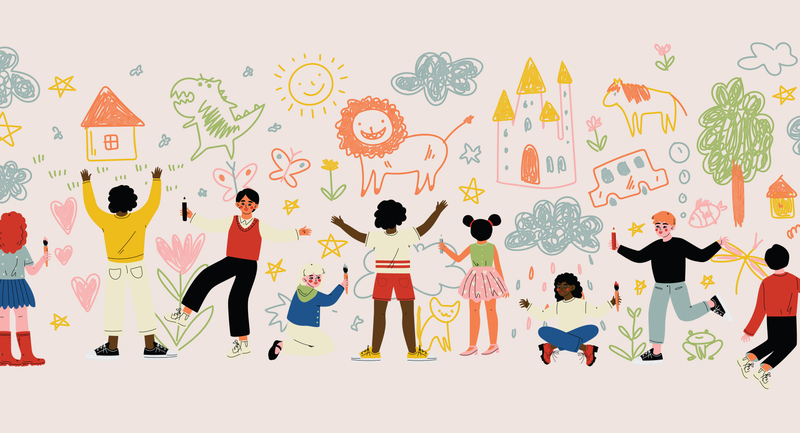March 1, 2017
•
5 min (est.)•
Vol. 74•
No. 6Let's Celebrate Personalization: But Not Too Fast
Asking crucial questions about implementing personalized learning will help you capture its power for your unique context.
Many a teacher, student, and parent feels depleted from time spent in regimented classrooms better suited to the early industrial revolution than to an era when the hallmark is change, the survival mechanism is flexibility, and business models reflect a focus on the individual. The devotion to standardization characteristic of many classrooms is drab compared with the color-rich world outside school. And the content of many curriculums looks faded and joyless compared with the scope of possibilities calling to learners from the Internet, packaged to be intriguing.
Enter "personalization." In the ideal world it promises, students will be able to study what they want to study, whenever they want to study it, and wherever they choose. The shiny mechanisms of technology will work to make every student a skillful reader and an adept mathematician. Teachers will be less stressed. Presumably, life at home will improve as well once parents are freed from monitoring Common Core math assignments. Sign us all up! The opportunity seems too good, too timely, to pass up.
Look a little deeper into the idea of personalization and to many (although certainly not all), the idea still sounds right. Its goal clearly is classrooms that honor the individual in a range of ways. It embraces the highly defensible tenet that learning has to happen in students, not to them, and it recognizes the reality that the diversity of students in today's classrooms makes it impossible to claim that one-size-fits-all learning makes sense. Personalization conjures up images of kids eagerly going to school—or at least somewhere to start learning—each morning and talking enthusiastically with parents and peers in the evening about what they've accomplished during the day.
But let's try to pin down personalization a bit more. The online Glossary of Education Reform (2015) says personalized learning refers to "a diverse variety of education programs, learning experiences, instructional approaches, and academic support strategies that are intended to address the distinct learning needs, interests, aspirations, or cultural backgrounds of individual students." It is, the Glossary says, an alternative to one-size-fits-all instruction; it's student-centered learning.
Although much that's inviting resides under the umbrella term of personalization, there are currently so many iterations of what personalization looks like that it begins to look like everything—and nothing. Personalization is written about variously as (to name just a few) personal learning plans, portfolio demonstration of learning, small schools, blended learning, community-based learning, increasing student voice and responsibility, project-based learning, inquiry learning, computer-based learning through adaptive technologies, dual enrollment, and anything-anywhere-anytime student-designed learning. In fact, the Glossary of Education Reform itself notes that personalization, as it's now used, "refers to so many different ideas, programs, and strategies that it's difficult to determine precisely what it refers to without qualifications, specific examples, or additional explanation." That caveat is cause for concern.
Schools are complex systems. Changing one element inevitably calls for changing others. Even modest departures from the familiar often cause disquieting tremors throughout the system. And we in education tend to look for the next big thing—the approach, text, or program—that will cure the ills that beset us. Often, there is considerable merit in whatever new instructional approach a community chooses, but then the potential of that approach is extinguished because the community adopts it in a manner suggesting that changing course in schools is as straightforward as changing socks. That unequivocally isn't the case.
All the varieties of personalization noted above are instructional in nature. There's no shortage of schools and school districts that have set out to make significant changes in their instructional approach without accomplishing what they envisioned. The problem is generally not that the proposed instructional change was without potential benefits, but rather that the forethought and planning necessary to initiate, develop, and ultimately institutionalize the change were much thinner than the complexity of the change warranted. The time-worn adage "measure twice, cut once" is worthy advice in schools as well as in carpentry!
So before undertaking a substantial instructional change like personalization, it would be wise for educators—both administrators and teacher leaders—to spend time reflecting on and responding to questions that reflect the complexity of such a change. The list of questions that follows isn't exhaustive, but it's a start.
It's always good to start with your purpose. Why is the idea of personalization appealing for your students, your faculty, your school? What is your vision for personalization? If your school focused significantly on personalizing learning for several months, what would an observer see after that time that he or she wouldn't see now? How would what that person observes represent an improvement?
Simon Sinek (2009) finds that productive organizations spend the most time on why they're taking a particular course of action before they begin to emphasize precisely what that action will look like or how the organization will achieve its goals. Too often in schools, we begin with what, never investing deeply in either why or how. Our overall purpose should inform both what and how—and a compelling why motivates people to contribute to the vision.
The answer to this question varies widely across different forms of personalization. When personalized learning is implemented through digital learning platforms that adapt to students' varied paces of learning in math, for example, students move through a prescribed math curriculum on varied timelines with varied supports. Likewise, dual enrollment programs typically use prescribed curriculums occurring simultaneously at both secondary and post-secondary levels. But when seen as "anything, anywhere, anytime learning," personalization can mean that students determine the curriculum. In between these extremes of prescribed and individualized curriculums, formats like project-based learning and independent study often suggest some general curricular frameworks within which students have varying amounts of choice.
It's unwise to select an instructional direction without clarity about how compatible that direction is with local understandings about the nature of curriculum. Instruction is a means of enacting curriculum. It works in service of a curriculum, and the match between the goals and the means of achieving those goals is critical. A bicycle is a great mode of transportation—unless you're trying to climb a mountain or cross an ocean.
It's also unwise to assume that any model will work for learners of all ages, in all subjects. Administrators and teachers should ponder how they know they're choosing the most appropriate audience(s) for their preferred approach to personalized learning. Is the form of personalization you're considering appropriate for all K–12 learners? Middle school? High school? Is it productive in all subjects? Most effective if used all day, or only in certain classes?
Bill, a colleague, mentored high school students who participated in a statewide personalization initiative in Vermont last year. These students created impressive products by pursuing student-directed inquiries outside the typical school structures of prescribed courses, schedules, and grading. Struck by the students' maturity and purposefulness as they worked over the period of a year, an observer suggested to the students that it would be wonderful if their whole high school career could be like this. The students, Bill told me, replied that although they'd loved the opportunity, they wouldn't want to do student-directed inquiry all the time. They felt there was much to be said for the structure and interaction of regular classes, too.
Can you imagine any students who might be poorly served, at least at some points in their learning journey, by the instructional approach you're considering? Might students with challenges like language acquisition, low proficiency in reading, emotional insecurity, a lack of background experiences, or even a weak attention span have trouble finding success with this learning structure? Might students who are advanced in academics or in a particular interest area find the approach limiting rather than invigorating?
If personalization is meant to enhance development for every student, it's important to decide how you'll address such instances. You might need to adopt (or abandon) certain practices and processes to ensure that this new approach provides equal access to excellent learning opportunities for all students.
For example, are there advanced materials and perhaps mentors to guide students who learn quickly and need to engage with an inquiry in greater depth or breadth? Will there be resources, guides, and teachers to help students who lack independence or fundamental reading skills develop those abilities as they work with a project-based task?
The way forward is likely to be smoother if teachers volunteer to implement an approach than it will if all teachers are expected to adopt it, but this leads to thorny questions. If teachers can opt in or out, is it acceptable for all 2nd grade teachers to volunteer but only half of the 3rd grade teachers? Will it work if the math department signs on but the science department doesn't? If the path forward is to begin with volunteers and incorporate other teachers over a period of three to five years, what are the implications for deeply embedded systems—for example, schedules, grading practices, and teacher evaluation—in the meantime?
There are doubtless teachers who, after years spent with highly prescribed curriculums, mandated pacing guides, and a quest for convergent answers, will find it liberating to embrace inquiry, project-based classes, and even anything-anywhere-anytime personalization. Many others will feel ill-equipped to envision and orchestrate more wide-ranging, unscripted routes to learning. What will teachers have to know, understand, and be able to do to feel confident and be competent in guiding successful personalization? Many necessary attitudes and skills will require a departure from usual practice; it will be key to identify what new learning teachers need to move from regimented time blocks, prescribed pacing guides, and the like to helping students establish their own goals, craft their own objectives, and design their own assessment criteria.
Educators may need guidance on logistical issues like how to orchestrate a classroom in which multiple things are happening simultaneously, give more than one set of directions, or monitor student progress. Imagine, for instance, trying to move from teaching mathematical algorithms to the whole class to serving as an effective coach for 30 students who receive their mathematical input from adaptive technologies, but still need teacher involvement in their learning.
Leaders should begin asking where they'll get the sustained staff expertise necessary to support a paradigm shift in teachers' beliefs, thinking, and practice. How will you address teacher variance in readiness and skills to make necessary alterations in practice? How will the school provide professional development that's rooted in teachers' classrooms?
Just as teacher roles have been shaped over decades by the centrality of standardization in schools, so have the roles of building principals. So what will it mean to become a leader for student-centeredness in a school? How should a leader guide a shift in beliefs and practices, and how can he or she distribute leadership for the change throughout the school? How does a principal become an instructional coach? What should be the relationship between the role of experts who will guide a revolution in classroom practices and the principal's role? How can a school leader handle inevitable discouragement with and overt resistance to personalized practices? And if personalization suggests that the individual is at the center of all decisions, how does the building leader consistently model personalization for teachers?
Even if parents opt into a school with a commitment to personalization, you'll need to educate them to provide a realistic understanding of why personalization is on the school's front burner, what to expect in personalized classrooms, what standards for quality work look like, and what roles they can best play in supporting their children in this context. If a neighborhood school with a captive audience pursues personalization, parent participation in and understanding of the change is both more complex and more essential. You'll need to identify ways your school can honestly address concerns that will inevitably surface, without abdicating core philosophies and practices. How will teachers and parents communicate effectively and with mutual understanding as the change progresses? What will the school do to ensure that all parents are welcome participants in the change?
Many schools' policies, procedures, and traditions might be an impediment to the intent of personalized classrooms. Is your established process of scheduling classes, assigning students to classes, grading, maintaining discipline, assigning class rank, and evaluating teachers in harmony with the goals and practices of the approach you're considering? Are building layout, classroom furnishings, the nature and use of the library/media center, and the availability of open spaces well-suited to the approach? Will your available technologies, materials, and expertise be adequate? Might any district- or state-level mandates and expectations conflict with your plans?
The goal here isn't to fully answer each of these questions before taking any action. Rather, it is to begin informed action—action based on full awareness of the complexity of meaningful school change and accompanied by judicious planning, deep study of all instructional possibilities, and vigilance as those possibilities unfold.
I'm genuinely excited by the growing chorus of voices advocating one or another version of personalizing learning. After all, over the last 35 years I've said often that differentiation is a way of thinking about teaching and learning that advocates beginning where individuals are. Personalization is a kind of differentiation—or perhaps multiple kinds. The dialogue about personalization gives me hope. On the other hand, it also gives me pause.
As Jennifer Carolan (2016) notes, we're in swampy territory if we see personalization as a silver bullet, or if we mistake it as the goal rather than as a means to a much larger end: linking students with meaningful learning, enabling collaboration that extends human understanding, and preparing students for a world that will demand of them both reason and wisdom. We're in for a crashing disappointment if we believe that any version of personalization can succeed in the classroom of a teacher who has yet to develop the skill or will to use it with understanding and fidelity.
We don't yet have much evidence that "personalization" works (Edwards, 2015)—or for whom, or under what circumstances. What we have is an idea, or a nest of ideas, that could nurture something more educationally promising than most of what we've seen over the previous two decades. It could also be an empty promise. We'll fulfill its promise not by jumping on the personalization bandwagon, but rather by deep thinking, informed planning, and wise leadership exercised reflectively and persistently, site by site, classroom by classroom.
I hope we have that in us.
References
•
Carolan, J. (2016). Personalization isn't about isolation. Education Week, 35(22), 25–27.
•
Edwards, H. (2015). Why Mark Zuckerberg wants to spend on personalized learning. Time. Retrieved from http://time.com/4132619/mark-zuckerberg-personalized-learning/
•
Glossary of Education Reform. (2015). Personalized learning. Retrieved from http://edglossary.org/personalized-learning/
•
Sinek, S. (2009). Start with why. New York: Portfolio/Penguin.









